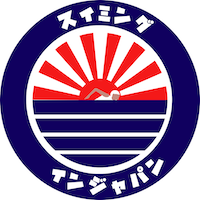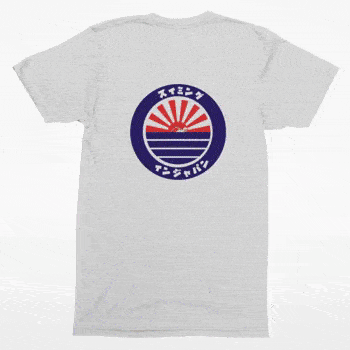If the following islands weren’t so damned difficult to get to, I’d be visiting them every weekend. But then again, they would also be better-known, more well-trodden, and a whole lot less wonderful and free.
The misleadingly named Izu Islands are technically still a part of Tokyo Prefecture, though this is a mere technicality: visiting them is like leaving Japan for another country entirely.
Or indeed, for the set of a James Bond fantasy.
The islands are the result of much undersea geological activity, and trace a line in the Philippine Sea southbound to the huge Ogasawara Archipelago, a set of mostly uninhabited volcanoes boasting beautiful flora and fauna, which peter out so far south that they have tropical climates.
Seeing as there are so many little bits of rock sticking out of the sea, it’s difficult to decide exactly where to stop, but one grouping, which is the easiest to get to by far, is the Izu Shichito (Izu 7 Islands):
Ōshima Island
Toshima Island
Niijima Island
Shikine-jima Island
Kōzushima Island
Miyakejima Island
Mikurajima Island
Hachijojima Island
FAQ – Swimming in the Izu Islands
.
Ōshima
Starting from the mainland and heading out south, the first of the 7 we will look at is Izu Ōshima (伊豆大島 Izu-ōshima). It’s the largest, with well-established infrastructure and amenities, but even then it’s charming, remote and oozing with natural wonders.
The volcano, Mount Mihara (三原山) at the top is hard to beat. It last erupted in 1986, and has an expansive, martian landscape that might have you thinking you’re on the much more famous Kilauea in Hawaii.
This one is popular for fishing, a range of beaches to suit all needs, and nature exploration. There are some stunning walks and views too.
Pros: It’s got everything you need and it’s quick to get to. The scenery is phenomenal. There’s enough space on the beaches for everyone.
Cons: It’s hard to navigate on a bicycle or on foot, so you can end up getting a lot of buses.
.
Toshima
Next in the series is Toshima (利島). It’s very small (under 2 square miles) and houses a small fishing village with some simple tourist accomodation in guest houses and homestays. The island is an attractive, pointed hill with steep sides - not much in the way of beaches then, but it is home to a lot of nature, with a school of dolphins based in the local waters, and daily fresh fish.
Pros: You’re not sharing it with many people, it’s a good place to get away from everything.
Cons: Camping and independent travel is not straightforward and may be difficult. Not much in the way of a recognisable beach to set up camp for the day’s swimming.
.
Niijima
The next island south has an entirely different character. Niijima (新島) is home to vast, long, white sand beaches that glimmer in the sunlight. It’s popular with surfers, has a few bars, spectacular outdoor onsen and camping facilities. At 24 kilometres squared it’s got more than enough room to explore, and while it doesn’t have the volcanic peaks of some of its neighbours, you’re guaranteed a good time here.
Pros: It’s popular in the warm seasons and can be a fun holiday destination if you’re in the mood to party with beautiful beach sunsets. The swimming is great.
Cons: Not the best of the bunch for stunning geophysical features.
.
Shikine-jima
Dwarfed in size by Niijima is Shikine-jima (式根島). It’s technically classed as a part of Niijima and is so close that an urban legend claims the two were previously joined, separated in a huge tsunami. With a small size and only 600 residents, it’s the best of all worlds - sandy beaches, mountain peaks, forest and remarkable oceanic hot springs. In fact, the incredible Jinata Onsen, a free access collection of rock pools that fills and empties with the tides alongside some fantastic rock jumping is regarded as one of Japan’s best.
It’s hard to find a better option if you’ve got to pick just one of the islands.
Pros: The island is littered with small bays to explore, with good swimming in both the northern and southern ends. Free camping beachside, plus those onsen!
Cons: It’s a small island, and so it gets packed in busy seasons. With limited accomodation options it can be a scramble for tent space, and noisy if you’re tired.
.
Kōzushima
Looming high and heavy in the not-so-distance, Kōzushima’s (神津島村) peak, 天上山 (Mount Tenjo) at 575 metres, takes us back to the volcanic wonder of Ōshima. It’s a much bigger island again and has lots to offer. Like its neighbour Shikinejima, it has free beach camping and plentiful jagged bays with rugged character, clear blue water to jump into from the rocks and some cute sandy beaches. It also houses some dramatic steep dunes, onsen, and a special area of wooden jumping and snorkelling infrastructure.
Pros: It’s almost like it was designed to enjoy swimming. There are purpose-built places to jump, on the beach free camp sites, and empty bays.
Cons: Being a larger island it’s not as easy to get around quickly or to see so much of the island on a short stay.
The final three islands of the 7 are even more remote.
.
Miyakejima
Miyakejima (三宅島) is an extremely active, small volcano with steep sides, pointing out of the Philippine Sea. The last big eruption was in the year 2000, and another large one in the 1980s caused a couple of schools to be buried in lava flow. Don’t worry about visiting though: tried and tested evacuation measures are of course in operation and people are actually banned from entering the central area due to potentially dangerous gases. The island is a designated national park, and home to loads of special hydrangeas, camellias and rare birds unique to the archipelago, such as the Japanese Pygmy woodpecker.
On the swimming front, you’re never far from a deserted beach of mysterious, volcanic black sand, and the welcoming turquoise-blue of the Philippine Sea. It’s a great spot for diving with loads of fish and dolphins in the waters. Of course, volcanic activity = warm onsen waters, and the island has plenty for its humble size.
Pros: If you like some nature with your swim, you’re in the right place. There’s a strong sense of community with regular cultural events.
Cons: The black sand might not be to everyone’s taste, and if you want to party, you might want to look elsewhere.
.
Mikurajima
Around 15 km directly south of Miyakejima, Mikurajima (御蔵島) has a similar conical, classic volcano appearance though in a more miniaturized form than its neighbour. The island has few inhabitants and few things to do … although what it lacks in diversity it makes up in quality: a tropical-jungle like interior made up of huge trees, surrounded by clear blue waters which are riddled with dolphins. It’s easy to get up close to them too, with plenty of boats to take you out snorkelling although diving is banned. There are some rocky beach areas dotted around and the water is clear.
Pros: It’s a nature paradise with spectacular sealife and solid quality seawater for swimming.
Cons: Not really the best for independent travellers, being a small community with few accommodation options and no camping to speak of means you have to get on board with itineraries and schedules.
.
Hachijojima
The farthest afield of the seven is the famous Hachijojima (八丈島). At 9 miles long it’s huge in comparison to its nearest neighbours, and is home to nearly 9000 residents. Interestingly the island has its own dialect, a relative of the old eastern Japanese language which is on the endangered languages list.
There are two sizeable volcanic mountains on the island: the long-extinct Mount Higashi, also known as Mount Mihara (701m), and Mount Nishi (AKA Hachijō-Fuji), which is even higher and at 854 metres is the highest in the archipelago, with some cracking views. The island is less active than its neighbours, with Nishi having not erupted for around 400 years, but of course there are still plenty of onsen.
As you would expect from an island of this size there are numerous opportunities to swim and bays and beaches to suit all tastes. Don’t miss the opportunities to dive and snorkel with almost guaranteed sea turtle sightings! In the centre it’s more built up, (by Izu island standards, meaning there might be someone else on the beach) head to the isolated south eastern shores for your own private beach!
Pros: There’s something for every taste: restaurants, bars, fun locals to meet, a range of accommodation types (including camping), the nature and volcanoes are stunning.
Cons: Though easily accessed by overnight ferry, it’s a long ride, especially going home. Being one of the larger islands it’s a little hard to get around on foot.
Note
Each island has its own advantages and disadvantages. One thing to take into account is getting there and back - although some may seem further afield they may indeed be better served by regular flights from the mainland than some which depend on ferry connections.
It isn’t always guaranteed that boats or planes will depart on schedule, as the weather conditions can turn volatile rather quickly, so be prepared! Wishing you all the best in your island adventures, and do share your photos and stories with us and get in touch here if you want to share some info with other travellers!
Ps. These islands are Tokyo in name alone. So bear in mind you should carry anything you might need. Take cash, toiletries, any daily essentials. There are local shops but they’re not always easy to access and best to be safe, eh?
Pps. It goes without saying that this also means you should absolutely prepare to take all trash, waste, recycling, whatever, home, or at least to the ferry or local bins. Let’s keep these islands beautiful and special.
Ppps. Make sure you line your stomach with the local green vegetable of the area - ashitaba (look for アシタバ, or 明日葉). It works magic with beach-induced hangovers.
FAQ – Swimming in the Izu Islands
1. Which Izu Islands are best for swimming?
Kozushima, Niijima, and Shikinejima are top choices for swimming thanks to their clear water and sandy beaches.
2. Are there natural hot springs near the beaches?
Yes, Shikinejima is famous for its seaside open-air hot springs like Jinata Onsen.
3. When is the best season to swim in the Izu Islands?
Summer months from July to early September offer warm waters and calm seas.
4. Do I need a reservation to swim at popular beaches?
No reservation is needed, but some campsites or accommodations nearby may require booking.
5. Are the Izu Islands suitable for family swimming trips?
Yes, many islands have lifeguarded beaches and calm waters ideal for children.
6. Are there any marine dangers to be aware of?
During summer, jellyfish can appear. Always follow local advisories and lifeguard instructions.
7. Can I snorkel directly from the beach?
Absolutely. Hachijojima and Miyakejima offer great snorkeling spots right off the beach.
8. Is wild swimming allowed in the Izu Islands?
Yes, but stick to designated swimming areas for safety and respect for marine conservation zones.
9. How do I reach the Izu Islands?
High-speed ferries, overnight boats, and flights from Tokyo connect to various islands.
10. Can I swim in volcanic crater lakes on the islands?
No, most crater lakes are protected or unsafe for swimming. Stick to coastal areas.
11. Are the beaches crowded during summer?
Main islands like Niijima get busy in August, but others like Mikurajima remain peaceful.
12. What type of swimwear is appropriate in Japan?
Standard swimwear is expected. Swim caps are not mandatory on beaches but may be in pools.
13. Are there showers and changing facilities at the beaches?
Yes, most popular beaches have basic amenities such as toilets and outdoor showers.
14. Can I do night swimming on the islands?
Not generally recommended due to safety and limited lighting, unless it's a supervised event.
15. Do any beaches have lifeguards?
Yes, especially during the peak season. Check island tourism websites for details.
16. Are any Izu Islands good for scuba diving too?
Yes, Hachijojima and Miyakejima are renowned for their rich underwater life and diving schools.
17. Can I swim near lava rock coastlines?
Use caution. Some areas are rugged and better suited for tide pooling than swimming.
18. Are the waters warm enough for swimming in spring or autumn?
Temperatures are cooler but possible for wetsuit users in May and October.
19. What marine animals might I see while swimming?
Expect to see colorful fish, sea urchins, and possibly dolphins off Mikurajima.
20. Are there any swimming festivals or events in the Izu Islands?
Some islands host beach festivals in August. Check local calendars for updated schedules.














